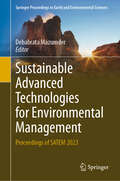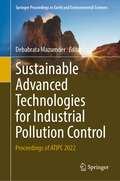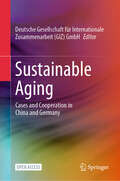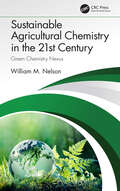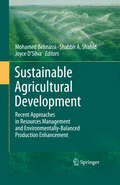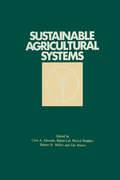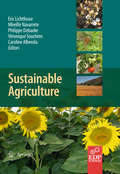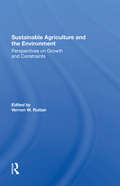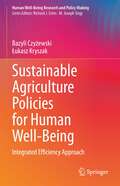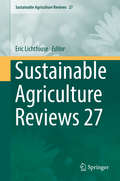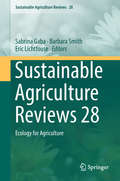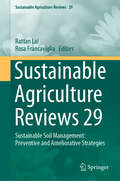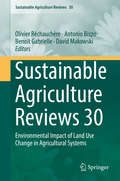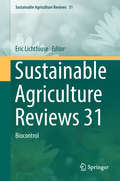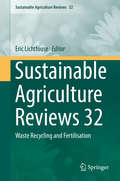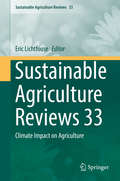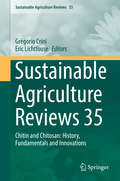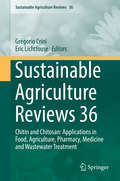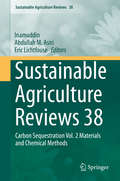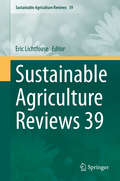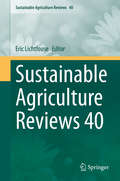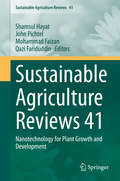- Table View
- List View
Sustainable Action in Economy and Society: Orientation for Change
by Reiner Manstetten Malte Faber Marc Frick Marco Rudolf Mi-Yong BeckerClimate change, species extinction, energy and raw material shortages are global challenges that are directly linked to our economic activity. They affect our very existence and jeopardize our ability to lead a good life today and in the future, both as a society and as individuals. The range of questions for which we need answers seems limitless and finding the "right" path for global change increasingly utopian. How do we maintain an overview in the face of highly complex interrelationships and interactions? How can we distinguish the essential from the non-essential? What fundamental relationships in nature do we need to take into account? What kind of economy is appropriate? What is just? And under what conditions are people willing to change? This book offers orientation. It deals with concepts from the natural sciences, economics and philosophy - including time, thermodynamics, scarcity, responsibility and justice - which enable an understanding of the upcoming transformation to sustainability from different perspectives. Ideally, they serve as guidelines for effective decisions and show how change is possible despite immense challenges. The book is aimed at anyone who wants to contribute to the transformation towards sustainability - whether in politics, business, administration or civil society.
Sustainable Additive Technologies and Innovative Manufacturing Techniques (Advances in Science, Technology & Innovation)
by Abdul Hai AlamiThis book offers a unique vantage point on converting ideas into products using additive manufacturing. Intended for novice and beginner designers, the process of industrial design is explained in order to translate verbal requirements into design constraints with the aid of the House of Quality approach. The product is then sketched and ported into a CAD software for modelling. The reader is then guided to the selection of the most appropriate additive manufacturing process, including PLA, resin, or metal 3D printing, along with material combination to meet their requirements. The book puts recyclability at the forefront of material discussion, from energy and circular economy perspectives, as they are central to achieving economic and energy efficiency. This is done by presenting the reader with do-it-yourself projects, which include processes like sand casting and lost PLA/Wax, that can be followed in a step-by-step manner using conventionally available tools.
Sustainable Advanced Technologies for Environmental Management: Proceedings of SATEM 2023 (Springer Proceedings in Earth and Environmental Sciences)
by Debabrata MazumderThis proceedings volume constitutes peer-reviewed full-length papers contributed by the Authors and tailored on various thematic areas of the 1st International Conference on Sustainable Advanced Technologies for Environmental Management (SATEM – 2023). The areas of research covered by these papers include but are not limited to: •Sustainable Water Quality Management •Advanced Water Treatment Technologies •Advanced Wastewater Treatment Technologies •Assessment and Control of Air Pollution •Solid and Hazardous Waste Management •Prevention of Groundwater Contamination •Wetland Management/Phyto- and Phyco-remediation •Case Studies in Urban and Rural Pollution Control •Management of Emerging Contaminants •Innovative Techniques for measuring environmental pollutants
Sustainable Advanced Technologies for Industrial Pollution Control: Proceedings of ATIPC 2022 (Springer Proceedings in Earth and Environmental Sciences)
by Debabrata MazumderThis proceedings volume constitutes peer-reviewed full-length papers contributed by the Authors and tailored on various thematic areas of the 3rd International Conference on “Advanced Technologies for Industrial Pollution Control” (ATIPC – 2022). The areas of research covered by these papers include but are not limited to: •Water quality monitoring and treatment in industrial area •Industrial effluent treatment, reuse and conservation •Monitoring of industrial emission and control •Industrial solid waste management •Handling and disposal of hazardous waste •Case Studies on industrial pollution control •Innovative technologies in industrial waste management
Sustainable Aging: Cases and Cooperation in China and Germany
by Deutsche Gesellschaft für Internationale Zusammenarbeit (GIZ) GmbHThis open access book discusses three areas in which Germany has long-standing experience and solutions that are valuable for other countries—care education, care insurance and standards for age-friendly city neighborhoods. It introduces the development background, application and shortcomings in the German and Chinese context, providing examples for from around the globe and showcasing the role of international cooperation projects in promoting knowledge exchange and advising on implementation in the country-specific context. Fast-paced demographic changes present a pressing challenge around the world. In Europe, the demographic problem, along with discussions on solutions, has been prevalent for many decades. And recently, it has also reached formerly developing countries in Asia, such as China. International cooperation, including international development cooperation, promotes the exchange of ways to tackle the social and economic challenges in order to find globally applicable solutions, thereby contributing to sustainable development. By presenting lessons learned in other countries, this book provides guidance for policy makers, city representatives and academicians seeking solutions for the challenges of an aging society in their own countries. Although the application of interventions is context-specific, the discussion and exchange on available solutions are essential to achieving socially sustainable and inclusive societies.
Sustainable Agricultural Chemistry in the 21st Century: Green Chemistry Nexus
by William M. NelsonAgriculture is one of the oldest and most global human enterprises, and as the world struggles with sustainable practices and policies, agricultural chemistry has a clear role to play. This book highlights the ways in which science in agriculture is helping to achieve global sustainability in the twenty- first century, and demonstrates that this science can and should be a leading contributor in discussions on environmental science and chemistry. The four drivers of this subject are presented, those being economic, environmental, regulatory and scientific, and help showcase agricultural chemistry as a dynamic subject that is contributing to this necessity of global sustainability in the twenty-first century.
Sustainable Agricultural Development
by Shabbir A. Shahid Mohamed Behnassi Joyce D'SilvaDue to many challenges (i.e. climate change, energy, water and land shortage, high demands on food, land grabbing, etc.), agriculture production potential is expected to be seriously affected; thus, increasing food insecurity and hunger in many already affected regions (especially in Africa). In this context, sustainable agriculture is highly recommended as an eco-system approach where soil, water, plants, environment and living organisms live in harmony. Innovative technologies and research should be developed to ensure sustainable agriculture and productivity using modern irrigation systems, improved varieties, improved soil quality, etc. In the meantime, the preservation of natural environment should be based on resource conservation technologies and best management practices. Sustainable Agricultural Development, not only raises the serious ethical and social issues underlying these huge environmental problems, but also aims at presenting successful experiences from all over the world in relation with sustainable farming, sustainable management of water and land resources, and innovative processes in livestock production. It also aims at providing inputs to decision making processes and encouraging the transfer of relevant know-how, technologies and expertise to different countries where similar agro-climatic conditions may exist; thus saving precious resources and promoting sustainable agricultural development as a relevant approach to tackle the food security challenge. Finally, this book focuses on the paradigmatic and policy dimensions and call for an innovative approach by analyzing the key themes in a complex and interrelated manner.
Sustainable Agricultural Systems
by Clive A. EdwardsA unique look at how the adoption of sustainable farming methods is being pursued throughout the world. This comprehensive book provides clear insight into research and education needs and the many points of view that come to bear on the issue of sustainability. Essential for agricultural leaders in research, education, conservation, policy making, and anyone else interested in creating an economically and environmentally sustainable agriculture worldwide.
Sustainable Agriculture
by Eric Lichtfouse Mireille Navarrete Philippe Debaeke Caroline Alberola Souchere VéroniqueSustainability rests on the principle that we must meet the needs of the present without compromising the ability of future generations to meet their own needs. Starving people in poor nations, obesity in rich nations, increasing food prices, on-going climate changes, increasing fuel and transportation costs, flaws of the global market, worldwide pesticide pollution, pest adaptation and resistance, loss of soil fertility and organic carbon, soil erosion, decreasing biodiversity, desertification, and so on. Despite unprecedented advances in sciences allowing to visit planets and disclose subatomic particles, serious terrestrial issues about food show clearly that conventional agriculture is not suited any longer to feed humans and to preserve ecosystems. Sustainable agriculture is an alternative for solving fundamental and applied issues related to food production in an ecological way. While conventional agriculture is driven almost solely by productivity and profit, sustainable agriculture integrates biological, chemical, physical, ecological, economic and social sciences in a comprehensive way to develop new farming practices that are safe and do not degrade our environment. In that respect, sustainable agriculture is not a classical and narrow science. Instead of solving problems using the classical painkiller approach that treats only negative impacts, sustainable agriculture treats problem sources. As most actual society issues are now intertwined, global, and fast-developing, sustainable agriculture will bring solutions to build a safer world. This book gathers review articles that analyze current agricultural issues and knowledge, then propose alternative solutions. It will therefore help all scientists, decision-makers, professors, farmers and politicians who wish to build a safe agriculture, energy and food system for future generations.
Sustainable Agriculture And The Environment: Perspectives On Growth And Constraints
by Vernon W RuttanThis book explores the resource and environmental constraints on sustainable growth in agricultural production into the middle of the twenty-first century. It presents contemporary concerns with the implications of natural resource availability and environmental change.
Sustainable Agriculture Policies for Human Well-Being: Integrated Efficiency Approach (Human Well-Being Research and Policy Making)
by Bazyli Czyżewski Łukasz KryszakThis book deals with the important topic of policies for sustainable agriculture, since food insecurity is a growing concern for policy makers and will affect the quality of life and well-being of generations to come. The authors provide a theoretical background to the concept of sustainable agriculture including its recent developments; monitor the current state of sustainability in agriculture in different regions of the world; and evaluate current agricultural policies to propose new solutions. They show practical ways of sustainability measurement that could be applied to different regions. The book takes into account sustainability indicators based on economic, social and environmental aspects and discusses the trade-offs between these three dimensions. It also answers the question of whether current agricultural policies contribute to balancing between the goals of agriculture---that of not just providing food but of contributing to the greater good---and how policies differ and have evolved across the world. Finally, it puts together the best practices of sustainability for the use of policymakers. The book pays particular attention to least developed countries where hunger and malnutrition are high, but where productivity should not come at the expense of environmental and social goals. This book is of use to a wide readership of policy makers, professionals and academics in the social and environmental sciences interested in the improvement of human life through sustainable agricultural policy implementation.
Sustainable Agriculture Reviews 27 (Sustainable Agriculture Reviews #27)
by Eric LichtfouseThis book deals with a rapidly growing field aiming at producing food and energy in a sustainable way for humans and their children. It is a discipline that addresses current issues: climate change, increasing food and fuel prices, poor-nation starvation, rich-nation obesity, water pollution, soil erosion, fertility loss, pest control and biodiversity depletion. This series gathers review articles that analyze current agricultural issues and knowledge, then proposes alternative solutions.
Sustainable Agriculture Reviews 28: Ecology For Agriculture (Sustainable Agriculture Reviews #28)
by Barbara Smith Eric Lichtfouse Sabrina GabaThis book presents ecological principles and applications of managing biodiversity in agriculture to decrease pesticide use and produce safe food. Major topics include ecosystem services biological pest control, conservation agriculture, drought stress, and soil biodiversity, carbon and fertilisation.
Sustainable Agriculture Reviews 29: Sustainable Soil Management: Preventive and Ameliorative Strategies (Sustainable Agriculture Reviews #29)
by Rattan Lal Rosa FrancavigliaThis book addresses the threats that hamper the achievement of sustainable soil management: soil erosion by water and wind, soil organic carbon loss, nutrient imbalance, salinization, contamination, acidification, loss of soil biodiversity, surface sealing, compaction and water logging. The specific focus is on preventive and ameliorative strategies for sustainable soil management.
Sustainable Agriculture Reviews 30: Environmental Impact of Land Use Change in Agricultural Systems (Sustainable Agriculture Reviews #30)
by Olivier Réchauchère Antonio Bispo Benoît Gabrielle David MakowskiThe originality of this book is to review and characterize the current body of scientific publications that describe the complete causal sequence from reorganization of agricultural production to land use changes (LUC) and the resulting environmental impacts. The chapters examine both the range of territorial reorganizations leading to LUC and the range of associated environmental impacts considered in the literature, including GHG emissions, atmospheric pollution, biodiversity impacts, water resources, and soil quality.
Sustainable Agriculture Reviews 31: Biocontrol (Sustainable Agriculture Reviews #31)
by Eric LichtfouseThis book presents advanced ecological techniques for crop cultivation and the chapters are arranged into four sections, namely general aspects, weeds, fungi, worms and microbes. Biocontrol is an ecological method of controlling pests such as insects, mites, weeds and plant diseases using other organisms. This practice has been used for centuries. Biocontrol relies on predation, parasitism, herbivory, or other natural mechanisms. Natural enemies of insect pests, also known as biological control agents, include predators, parasitoids, pathogens, and competitors.
Sustainable Agriculture Reviews 32: Waste Recycling and Fertilisation (Sustainable Agriculture Reviews #32)
by Eric LichtfouseThis book summarise advanced knowledge and methods to recycle waste and fertilise soils in agriculture. In the near future, waste recycling will no longer be an option because natural resources become rare and costly, urbanisation is blooming and population is growing. In theory, most waste could be recycled. In practice, most waste is wasted. Remarkable aspects include the concepts of waste hierarchy eco-houses in smart cities, microbes and fungi for plant nutrition, and benefits of legume cultivation, biochar application and agropastoralism.
Sustainable Agriculture Reviews 33: Climate Impact on Agriculture (Sustainable Agriculture Reviews #33)
by Eric LichtfouseThis book presents advanced knowledge on the relationships between climate change and agriculture, and various adaptation techniques such as low tillage, salt-adapted beneficial microbes and closed systems. Climate change is unavoidable but adaptation is possible. Climate change and agriculture are interrelated processes, both of which take place on a global scale. Climate change affects agriculture through changes in average temperatures, rainfall and climate extremes; changes in pests and diseases; changes in atmospheric carbon dioxide; changes in the nutritional quality of some foods; and changes in sea level.
Sustainable Agriculture Reviews 35: Chitin and Chitosan: History, Fundamentals and Innovations (Sustainable Agriculture Reviews #35)
by Eric Lichtfouse Grégorio CriniThis book reviews recent research and applications of chitin and chitosan, as natural alternatives of fossil fuel products, in green chemistry, energy, biotechnology, bioprinting, medicine, water treatment, agriculture and food science. Chitin and chitosan products are polysaccharides derived from food waste of crustaceans and fungi, and thus are cheap, abundant, sustainable, non-toxic, recyclable and biocompatible.
Sustainable Agriculture Reviews 36: Chitin and Chitosan: Applications in Food, Agriculture, Pharmacy, Medicine and Wastewater Treatment (Sustainable Agriculture Reviews #36)
by Eric Lichtfouse Grégorio CriniThis book reviews recent research and applications of chitin and chitosan, as natural alternatives of fossil fuel products, in medicine and pharmacy, agriculture, food science and water treatment. Chitin and chitosan products are polysaccharides derived from food waste of crustaceans and fungi, and thus are cheap, abundant, sustainable, non-toxic, recyclable and biocompatible. Remarkable applications include food additives and preservation, packaging materials, biopesticides and fertilisers, drug delivery, tissue engineering, bioflocculation and dye removal.
Sustainable Agriculture Reviews 37: Carbon Sequestration Vol. 1 Introduction and Biochemical Methods (Sustainable Agriculture Reviews #37)
by Eric Lichtfouse Inamuddin Abdullah M. AsiriThis book presents sources of carbon dioxide emission, related environmental issues and methods for carbon dioxide utilization, storage, analysis, modeling and optimization. This first volume focused on biochemical methods of carbon dioxide sequestration such as forestry, biomineralization, geo-chemo-mechanical, mangrove plantation and biowaste.
Sustainable Agriculture Reviews 38: Carbon Sequestration Vol. 2 Materials and Chemical Methods (Sustainable Agriculture Reviews #38)
by Eric Lichtfouse Inamuddin Abdullah M. AsiriThis book presents materials and physical methods for carbon dioxide sequestration. Materials include nanosponges, titanium oxide/zeolite hybrids, classical absorbents, metal oxides, ionic liquids, alkaline soils and metal organic frameworks. Methods include cryogenic capture, adsorption, solvent dissolution and soil sequestration.
Sustainable Agriculture Reviews 39 (Sustainable Agriculture Reviews #39)
by Eric LichtfouseThis book reviews recent research advances in sustainable agriculture, with focus on crop production, biodiversity and biofuels in Africa and Asia.
Sustainable Agriculture Reviews 40 (Sustainable Agriculture Reviews #40)
by Eric LichtfouseThis book reviews recent research advances in sustainable agriculture, with focus on crop production, biodiversity and biofuels in Africa and Asia.
Sustainable Agriculture Reviews 41: Nanotechnology for Plant Growth and Development (Sustainable Agriculture Reviews #41)
by John Pichtel Shamsul Hayat Mohammad Faizan Qazi FariduddinThis book presents recent developments involving the role of nanoparticles on plant physiology and growth. Nanotechnology applications include improvement of agricultural production using bio-conjugated NPs (encapsulation), transfer of DNA in plants for development of insect pest-resistant varieties, nanoformulations of agrochemicals such as pesticides and fertilizers for crop improvement, and nanosensors/nanobiosensors in crop protection for identification of diseases and residues of agrochemicals. Recent findings on the increased use of nanotechnology in agriculture by densely populated countries such as China and India indicate that this technology may impart a substantial impact on reducing hunger, malnutrition, and child mortality.


